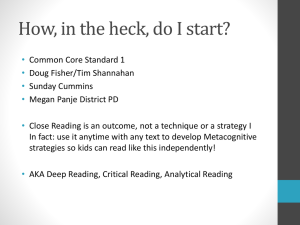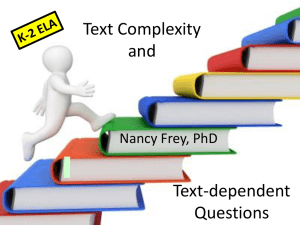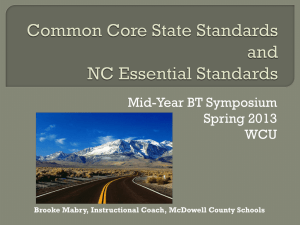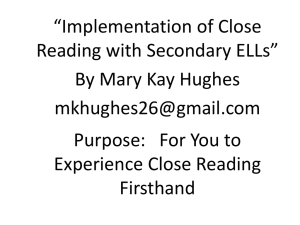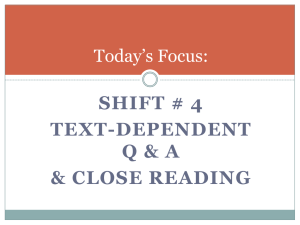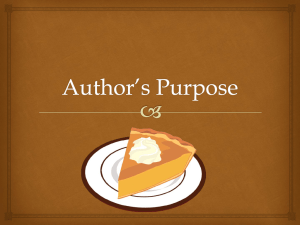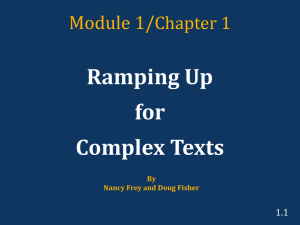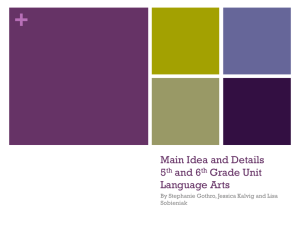File - Eng/LA Teacher leader Network
advertisement
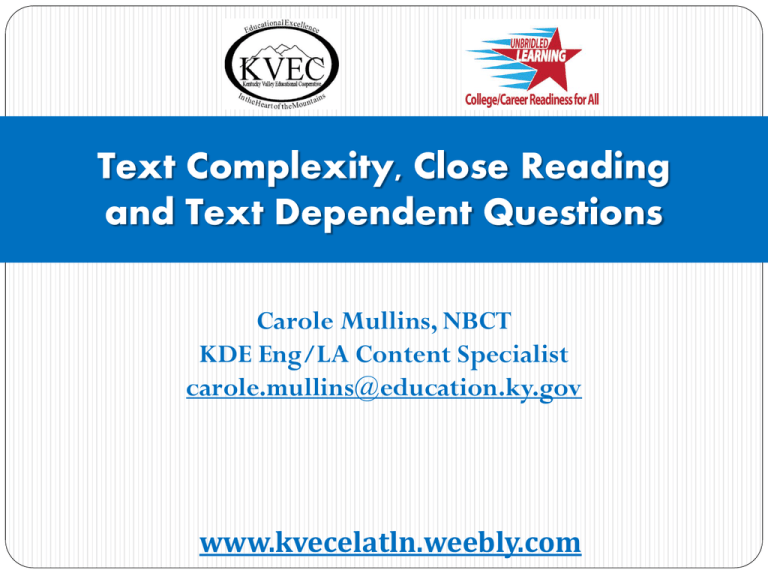
Text Complexity, Close Reading and Text Dependent Questions Carole Mullins, NBCT KDE Eng/LA Content Specialist carole.mullins@education.ky.gov www.kvecelatln.weebly.com Today’s Targets I can recognize important instructional shifts demanded by the KCAS Eng/LA and Literacy Standards. I can implement strategies that address instruction for comprehending and writing about complex text. The CCSS Requires Three Shifts in ELA/Literacy 1. Building knowledge through content-rich nonfiction 2. Reading, writing and speaking grounded in evidence from text, both literary and informational 3. Regular practice with complex text and its academic language Do my students spend more class time in text or out of text? Time – In and Out of the Text 1.The shifts require experience within the text – building knowledge primarily through reading, using evidence that can only be found in text, and exposure to academic vocabulary found in text. 2.By grounding the discussion in the text itself, all students are given an equal opportunity to engage. The text becomes a shared experience in learning about any topic. 5 Time – In and Out of the Text (con’t) 3.Requiring students to persevere through difficult text builds critical reading muscles. 4.Those reading muscles are what students will need to be successful in college and career – reading difficult subject matter or technical job related information without anybody to support them is the critical skill necessary for success. 6 Text Complexity and The KY Core Academic Standards for ELA and Literacy in History/Social Studies, Science & Technical Subjects Text Complexity: Raising Rigor in Reading By Douglas Fisher, Nancy Frey, Diane Lapp ISBN: 978-0-87207-478-1 The Crisis of Text Complexity – Complexity of texts students are expected to read is way below what is required to achieve college and career readiness: • High school textbooks have declined in all subject areas over several decades • Average length of sentences in K-8 textbooks has declined from 20 to 14 words • Vocabulary demands have declined, e.g., 8th grade textbooks = former 5th grade texts; 12th grade anthologies = former 7th grade texts – Complexity of college and careers texts has remained steady or increased, resulting in a huge gap (350L) Shift in Instruction “. . . it is important to recognize that scaffolding often is entirely appropriate. The expectation that scaffolding will occur with particularly challenging texts is built into the Standards’ grade-by-grade text complexity expectations, for example. The general movement, however, should be toward decreasing scaffolding and increasing independence both within and across the text complexity bands defined in the standards.” CCSS Appendix A Text Complexity: What does it mean to you? Anchor Standard R.CCR.10 Read and comprehend complex literary and informational texts independently and proficiently. 11 R.L.6.10 By the end of the year, read and comprehend literature, including stories, dramas, and poems, in the grades 6–8 text complexity band proficiently, with scaffolding as needed at the high end of the range. R.L.7.10 By the end of the year, read and comprehend literature, including stories, dramas, and poems, in the grades 6–8 text complexity band proficiently, with scaffolding as needed at the high end of the range. R.L.8.10 By the end of the year, read and comprehend literature, including stories, dramas, and poems, at the high end of grades 6–8 text complexity band independently and proficiently. R.L.9By the end of grade 9, read and comprehend literature, including stories, dramas, and poems, in the grades 9–10 text complexity band proficiently, 10.10 with scaffolding as needed at the high end of the range. By the end of grade 10, read and comprehend literature, including stories, dramas, and poems, at the high end of the grades 9-10 text complexity band independently and proficiently. R.L.1112.10 By the end of grade 11, read and comprehend literature, including stories, dramas, and poems, in the grades 11–CCR text complexity band proficiently, with scaffolding as needed at the high end of the range. By the end of grade 12, read and comprehend literature, including stories, dramas, and poems, at the high end of the grades 11–CCR text complexity 12 band independently and proficiently. What Makes Text Complex? Educational Leadership, March 2012 The Challenge of Challenging Text Timothy Shanahan, Douglas Fisher and Nancy Frey • Vocabulary: Knowledge of word meaning • Sentence Structure: How the words operate together • Coherence: How particular words, ideas, and sentences in text connect with one another • Organization: The patterns authors use to communicate complex information • Background Knowledge: The reader’s prior knowledge Assessing Texts Text Complexity Quantitative measures Qualitative values Task and Reader considerations Ripe Figs by Kate Chopin As a small group, read “Ripe Figs” and answer the three questions provided…. Discussion – On a scale of 1 to 10, how would you rate the overall complexity of this text? – What features of this text support your rating of its complexity? – At what grade level might this text be appropriate for instruction? Why? Determining Text Complexity 1. Determine the quantitative measures of the text. 2. Analyze the qualitative measures of the text. 3. Reflect upon the reader and task considerations. 4. Recommend placement in the appropriate text complexity band. Reader and Task 17 Quantitative Measures Ranges for Text Complexity Grade Bands Stretch Texts are needed Step 1: Quantitative Measures Measures such as: Word length Word frequency Word difficulty Reader and Task Sentence length Text length Text cohesion 19 Step 1: Quantitative Measures The Quantitative Measures Ranges for Text Complexity: This document outlines the suggested ranges for each of the text complexity bands using: 1. 2. 3. 4. 5. Lexile Text Measures Accelerated Reader (ATOS Book Levels) Frye DRA Other readability measures 20 Step 2: Qualitative Measures Reader and Task Measures such as: Levels of meaning Levels of purpose Structure Organization Language conventionality Language clarity Prior knowledge demands 21 Qualitative Measures Resources The Qualitative Measures Rubrics for Literary and Informational Text: http://www.ksde.org/Default.aspx?tabid=4778#TextRes The rubric for literary text and the rubric for informational text allow educators to evaluate the important elements of text that are often missed by computer software that tends to focus on more easily measured factors. Another Qualitative Measures Resource Step 3: Reader and Task Considerations Considerations such as: Motivation Knowledge and experience Purpose for reading Reader and Task Complexity of task assigned regarding text Complexity of questions asked regarding text 24 Step 3: Reader and Task Considerations Questions for Professional Reflection on Reader and Task Considerations: The questions provided in this resource are meant to spur teacher thought and reflection upon the text, students, and any tasks associated with the text. 25 Step 4: Recommended Placement Reader and Task After reflecting upon all three legs of the text complexity model we can make a final recommendation of placement within a text and begin to document our thinking for future reference. 26 Additional Resource: Recommended Placement Form Template for Text Complexity Analysis and Recommended Placement Form: http://www.ksde.org/Default.aspx?tabid=4778#TextRes The one-page template provides an opportunity to record the thinking involved in recommending the placement of a specific text into a text complexity band. Keeping a record of such analysis and thinking might be useful documentation in the case that any questions arise in the future. Teaching with Complex Texts A Focus on “Close Reading” “One of the key requirements of the Common Core State Standards for Reading is that all students… must be able to read and comprehend independently and proficiently the kinds of complex texts commonly found in college and careers.” --CCSS Appendix A, pg. 2 Why Depth through “Close Reading” Matters Close reading instruction: Requires careful attention to how the text unfolds through asking text-dependent questions. Focuses on building knowledge through the strategic use of textdependent questions. Can prepare students for the kinds of reading tasks they will encounter after graduation. Despite its name, close reading has a lot more to do with writing than reading! Close Reading Dr. Douglas Fisher Close Reading and the CCSS, Part 1 http://www.youtube.com/watch?v=5w9v6zUg3Y&feature=relmfu Close Reading Dr. Douglas Fisher Close Reading and the CCSS, Part 2 http://www.youtube.com/watch?NR=1&v=JhGI5zdjp vc&feature=endscreen Use a short passage “Read with a pencil” Note what’s confusing Pay attention to patterns Give your students the chance to struggle a bit Creating a Close Reading “Every book has a skeleton hidden between its covers. Your job as an analytic reader is to find it.” Adler and Van Doren, 1940/1972 Close Reading of a Sample Text What did you do as a “Close Reader” when you read the excerpt from ? Reflect on this question then explain it to someone at another table how you could teach this skill to your students. Moves from literal to interpretive Requires students to return to the text to formulate responses Text-dependent Questioning Why Ask Text Dependent Questions 80 to 90% of the ELA Reading Standards in each grade level require text dependent analysis One of the first and most important steps to implementing the ELA Common Core Standards is to focus on identifying, evaluating, and creating text-dependent questions Close/Deep Reading, the kind encouraged by the common core standards, asks students to “read like a detective”, looking closely for details to help students “write like a reporter” in one of the Three Modes of Writing. Rather than asking students questions about their prior knowledge or experiences, the standards expect students to struggle with text-dependent questions www.achievethecore.org/steal-these-tools/text-dependent-questions 80-90% of (CCSS) reading standards require text-dependent analysis yet over 30% of questions in major textbooks do not. Sue Pimentel, Lead Author of Common Core State Standards for ELA/Literacy 39 The Problem With Classroom Texts Existing questions in many reading programs were designed for a different set of standards. Therefore, we must align our reading series with KCAS and create or modify existing questions when possible to text dependent questions. 40 What are Text-Dependent Questions? Text-dependent questions: Draw the reader back to the text to discover what it says. Have concrete and explicit answers rooted in the text. Frame inquiries in ways that do not rely on a mix of personal opinion, background information, and imaginative speculation. Inferences Probe each argument in persuasive text, each idea in informational text, each key detail in literary text, and observe how these build to a whole. CONSIDER THIS… • The teacher is usually the person who asks the questions during a discussion. In a longitudinal study of elementary and secondary school classes, Dillon (1990) found that each student asks only one question per month on average. Teachers must take deliberate steps to get their students to ask questions. ADDITIONALLY… • Teachers often pose a question to the whole class but then call on only a few hands… • Is the question you are asking one that you want the whole class to consider? • Yes? Then why call on volunteers to answer? • Pose the question to the whole class and indicate how you want students to answer: • Think, Pair, Share • Think , Write, Share • Think, Write, Show Differences in Depth: Text versus Non-Text-Dependent Questions Non-Text-Dependent Questions Are books without pictures or conversations useful? How would you react if you saw a talking rabbit? Would Alice have followed the rabbit down the hole had she not seen it look at a watch? What do you know about Lewis Carroll? Text-Dependent Questions What kind of books does Alice find useful? How did Alice react when she saw a talking rabbit? Why did Alice follow the rabbit down the rabbit-hole? What does the reader know about the rabbit? A Guide to Creating Text-Dependent Questions for Close Analytic Reading “Close Reading” of a Stand-Alone Text Activity • Read the opening of Brian Lies’ Bats at the Beach • With a partner write one Text-Dependent Question • Share your question with others at your table Evaluate your TDQ based on the samples provided Progression of Text-dependent Questions Whole Opinions, Arguments, Intertextual Connections Across texts Inferences Entire text Author’s Purpose Segments Vocab & Text Structure Paragraph Key Details Sentence Word Part General Understandings Inferences Probe each argument in persuasive text, each idea in informational text, each key detail in literary text, and observe how these build to a whole. Focus on Instruction – Close Reading and Text-Dependent Questions Attributes of Close Reading lessons: Selection of a (brief), high quality, complex text Individual reading of the text Rereading the text Text-based questions and discussion that focus on discrete elements of the text Discussion among students Writing about the text Excerpt (1963) By Martin Luther King, Jr. Answering the Dilemma of Increasing Writing Scores! Text Complexity: Regular practice with complex text and its academic language. Close Reading Close Reading: Despite its name, close reading has a lot more to do with writing than reading! Why is it important? “Close reading” is an essential college skill, regardless of a writer’s discipline. Text-dependent questions: Draw the reader back to the text to discover what it says. Teachers frame questions in ways that do not rely on a mix of personal opinion, background information, and imaginative speculation. Text Dependent Questions Congruent Assessments Text-Dependent Questions Write your own Text-Dependent Question for a familiar piece of text.

